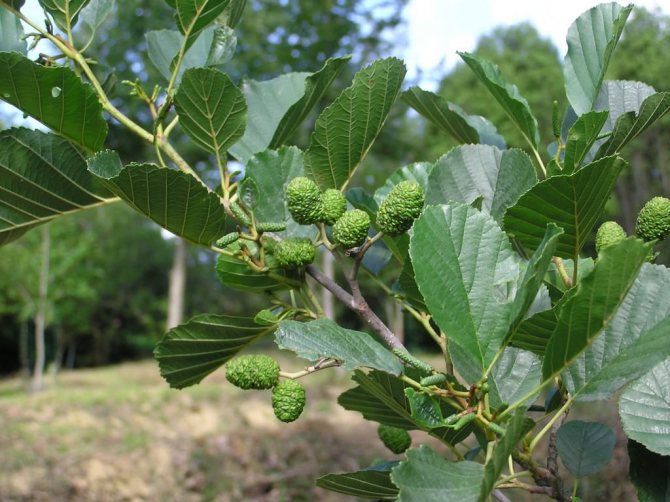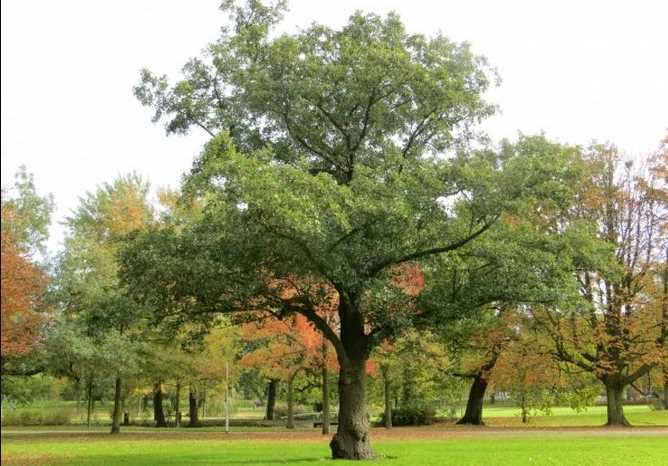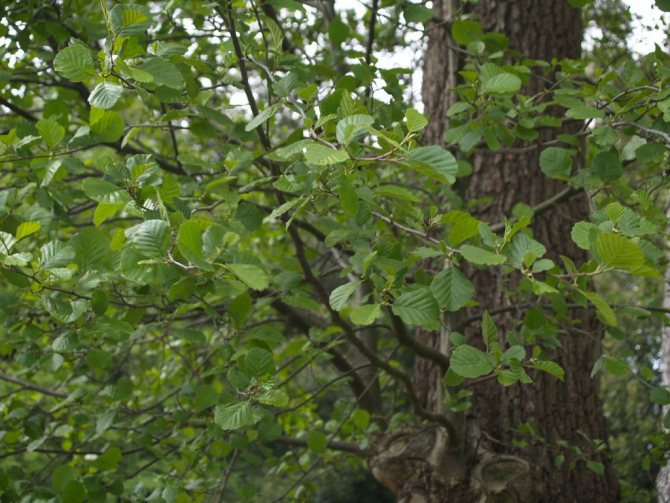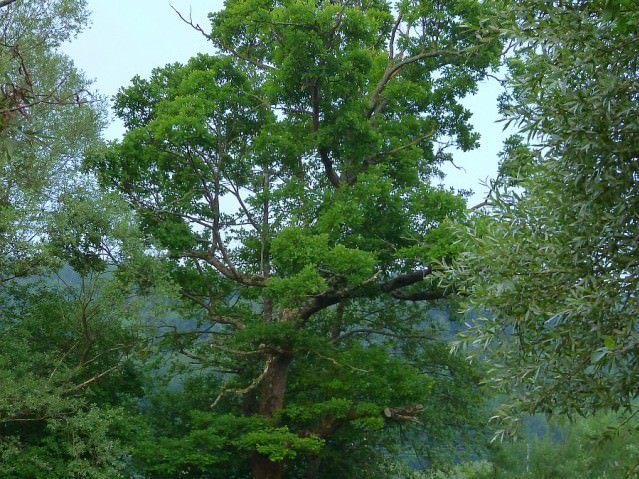The genus alder (Alnus) includes from twenty-three to forty species of deciduous trees and shrubs. Most of them grow in the temperate climate of the northern hemisphere. Some species are found in South America and Japan. In the northern regions, this type of tree forms mixed forests with coniferous species, and in the southern latitudes of Eurasia it grows in beech and oak groves.
Alder in the garden
The Black prefers wet floodplains of rivers, so its main habitat is the valleys of the Danube, Elbe, Rhine, Weser, Prut, Olta, Sereti and other rivers of Western Europe. This type of alder is also found in the damp lowlands of Cyprus. In Lebanon, the eastern one has become widespread, growing both in separate groves and next to oak, pine and plane tree. In China it is found on the banks of mountain rivers, and in Korea - in low-lying floodplains. In Northern Vietnam, some species grow only in mountainous areas. Unfortunately, in Great Britain, short-sighted human actions have led to the complete destruction of alder forests, which previously occupied a vast territory of the country.
Family: Birch (Betulaceae), order Fagales.
Homeland: Europe.
Flowering: Most species bloom in early spring, but some bloom in October–December.
Growth: fast.
Light: light-loving, but easily tolerates shade.
Temperature: moderate.
Watering: plentiful.
Reproduction: seeds, root sprouts.

The photo shows alder fruits
Unpretentious to the composition of the soil. And, despite the fact that it can most often be found along river banks and in grassy swamps, these trees can grow on sandy, clay and dry soils. This is explained by the fact that black and bearded alders have so-called stilt roots, which serve for reliable fixation on unsteady and swampy swampy hills. Planting such trees prevents soil erosion and the spread of waterlogging in surrounding areas.
In addition, it refers to plants that are capable of enriching the soil with nitrogen, which, when reacting with other substances, forms nitrogenous fertilizers. At the same time, nitrogen can inhibit the vital activity of pathogenic microflora and help increase the number of beneficial microorganisms.
There are two points of view about the origin of the species name. Some scientists claim that the word alder came from the Celtic language and means “al” - “at”, and “alis” - “water”, that is, “shore”. This hypothesis is supported by the fact that it grows more often in humid places. But according to the Indo-European lexeme, this word can be translated as brown or red, which is associated with the color of the bark and wood.
Description
As can be seen in the photo presented, it is a deciduous plant or shrub. Moreover, this form is determined by the habitat and growing conditions. Cylindrical shoots have a greenish triangular core. They contain oval or round growths necessary for gas exchange in the stems, called lenticels. The buds are located on small stalks and have two scales.
The photo shows that alder leaves are whole, simple, have a round or ovoid shape with jagged edges, lanceolate forms are rare. The arrangement is alternate, petiolate, the stipules fall off quite early. If you look closely, you can see on the branches, leaves and even buds an edge formed by epidermal cells, called trichome. The staminate and pistillate flowers of alder are monoecious. The difference is that in the upper part of the shoot the staminate flowers form long “earrings”, and at the base of the shoot the pistillate flowers are collected in the form of spikelets. There is a difference in the period of inflorescence formation. If the staminates begin to develop already in mid-summer and complete their formation only after 5–6 months, then the pistillates form in the fall and it takes only 1–2 months.
The male flowers shown in the photo can be located one at a time or three at a time on one peduncle, arranged spirally on the stem of the catkin. There is a simple four-leaved perianth and four stamens with rather large anthers and short filaments. Female flowers are arranged in large scales in pairs. Over time, these scales become very hard and form bumps. The flower itself consists of an ovary with two columns. After pollination, at least 85 days must pass for the flower to be fertilized. And only in October the seeds are fully ripened.

Alder cones
All alder species bloom in early spring, as early as March. The exception is the seaside, which blooms from late October to early December.
Flowering coincides with the blooming of leaves. This fact ensures better pollination of trees. The alder fruit is a nut with one seed in the middle. The nut is equipped with two stigmas and wings, which carry it over long distances. However, wingless forms are also found. Seed distribution occurs in the cold season, during strong gusts of wind, rain or snowfall. The cones can remain on the tree until the beginning of the next season and fall off during the next spring flowering.
Propagated by seeds and root shoots.
Habitats of different types of alder
- Most alder species are concentrated in the temperate climate of the Northern Hemisphere.
- Some species reach South America.
- In Asia, the range extends to Northern Vietnam, where alder prefers mountains.
- In the northern regions, more cold-resistant species make it to the cold tundra.
- In Norway, gray alder is spread throughout the entire forest area.
- A little to the north, it grows next to coniferous trees, and further to the south, it mixes with oak and beech.
- Great Britain previously had many alder forests at its disposal, but widespread deforestation and industrial activity of people destroyed them.
- Black alder can be found in the forests of Germany, scattered throughout the valleys near the Rhine, Danube and Weser. It is also found in Hungary and Romania.
- Poland has included black alder in the composition of deciduous plantings, and gray alder is common as an admixture.
- In Lebanon, eastern alder has settled along the coast and foothills, near the western slopes. There are whole groves of it, both pure and mixed with downy oak.
- Japanese alder grows on the island of Hokkaido, Japan.
Attention! There are more than 40 species of alder in nature. Therefore, its appearance largely depends on its habitat. The main criteria are growth, foliage shape and tree color.
Types of alder
Black alder
This is a typical representative of the genus. It is also called European, based on its largest distribution area. Its leaves are quite sticky, and therefore it has a second name – “sticky”.
Alder solid
It grows as a shrub, approximate height – 3m. Lives in Kyushu, a Japanese archipelago. It easily tolerates strong sea winds, the leaves have teeth, the branches are thin and flexible, sometimes they have a gray coating on them.
It begins to bloom in March, mostly in pairs of earrings. Loves humid climates. Has hard wood.
Alder
Widely distributed in China as a wild plant. Nowadays, it can be found in British parks. A distinctive feature is its height, about 40m, as well as its branches hanging down. The leaves have an oblong and narrow shape. Has single earrings.
Most alder species are susceptible to fungal attack. Marsupial fungi prefer female earrings; when they get inside, they cause them to grow.

Seaside alder
Another type of alder that grows as a bush, but has a size that is not inferior to a tree. The description is typical. Lives only in North America.
The crown of the tree is of medium density, the trunk is thin and tall, sometimes reaching up to 10 m. If you have a desire to grow such an alder on your site, remember that it is very demanding when it comes to watering and fertilizers.
Italian alder
It is found naturally in Albania and closer to the south of Italy. The plant does well in a variety of soil types, but its preferred habitat is near water.
Height is about 20-25 m, trunk diameter is 1 m. The foliage is smooth and dense, oval in shape.
A mature alder tree can reach more than 3 meters in height. Alder is also called a deciduous tree.
Flowering of the plant begins in July and lasts until mid-September. The flowers are white interspersed with yellow. The flowers form racemes, up to approximately 15 cm long.

In our area, the following types of alder are most often found, namely: gray alder and sticky alder, also called black alder.
The height of black alder reaches 30 m, and the diameter is 80 cm.
Gray alder often grows in the form of a bush; if it grows as a tree, its maximum height will be approximately 15 m and a thickness of 30 cm.
What appearance is typical for these types of alder?
Their main differences are the shape of the foliage and the color of the bark.
Black alder has a darker color, and the leaves, as if soaked in glue, are shaped like an inverted egg, or even even round.

The leaves of gray alder are similar in shape to an ellipse, pointed closer to the edges, and not very sticky.
A - black (sticky) alder: 1 - cones; 2 - inflorescences of staminate flowers; 3 - sheet; b - gray alder: 1 - cones; 2 - inflorescences of staminate flowers; 3 - sheet
Habitats
As its habitat, Black Alder prefers to choose everything that implies a constant amount of moisture: streams, rivers, lakes, old swamps.
Its relative, the gray alder, likes to climb higher, where it is warm and dry.
Also, cleared areas, fires, and wastelands are suitable for its habitat. But in case of high humidity, it also feels good.
Black alder bark
The alder was nicknamed sticky because of its sticky and tenacious leaves. The name black alder comes from the color of the old trunks of this tree; a black bark forms on them.
For your information. If you come across a whole planting of alder trees, you can be sure that there is definitely a source of moisture very close by. It can be in the form of a spring, a small river, fast underground water flowing close to the surface of the earth. In wetlands and lowlands, black alder very often lies in wait; for it, such conditions are very suitable.
Alder, or in other words, false alder, is a very useful species of wood. The fruits of the alder tree are called drupes.
Alder holds the palm among the flowering trees of Russia, proudly blooming before anyone else.
Alder begins to bloom in April, when there is no foliage yet.
Pollination occurs with the help of wind.
After winter, there are still heaps of snow in the forest, some trees have a snow cap, and the alder is already showing off its reddish crown.
Pollination:
- When you get a little closer, you will be able to see beautiful brown-red catkins hanging down among the branches of the tree.
- After some time, the earrings become longer, enlarged, and lots and lots of pollen fill the surrounding air.
- When pollen falls on the nearest neighboring tree, it helps pollinate the red female flowers.
- Soon greenish cones appear, containing seeds.
In places where alder trees grow, conditions are created for the formation of mycorrhiza and the appearance of different types of fungi.
In addition, the plant is very attractive to all kinds of parasitic fungi, as an excellent platform for growth. On the trunks and branches of alder appear: tinder fungi, true and false, alder athelia, concentric daldinia, brown hypoxylon.
Alder polypore
What is the reason for such an accelerated flowering process in alder?
The tree begins to prepare for spring flowering in the hot summer.
- When half of summer is already behind us, small male earrings gradually begin to appear on the alder, one by one.
- Their growth lasts until the last warm days of autumn.
- And by the beginning of winter, they are already fully formed. A supply of pollen for the future is already contained in them, waiting in the wings.
- As soon as the sun gives a little of its warmth, sleep will slowly begin to dissipate.
- The flowers of females look like small lush spikelets.
- When the pollination process ends, alder flowers are sealed with viscous resin and become strong cones.
- Before the onset of autumn, the cones will finally harden, and so they will hang in a sealed state until spring comes. Seeds ripen inside the cones.
With the arrival of spring, the catkins of a male tree grow up to 2-3 cm in just a day. The scales open one by one and pollen gradually begins to seep out.
You just have to touch the earring a little, and like fairy dust, in a smooth, graceful motion, the pollen will scatter around.
The alder tree is helped in its reproduction by the wind, which carries a significant amount of pollen throughout the area.
Interesting. One small earring can contain up to 30 g of pollen.
The primacy of alder in flowering order is not its only distinguishing feature. Alder blooms earlier than all other trees in Russia.
Another feature is that the fruits ripen closer to winter.
What conditions does alder need to grow:
- No particular soil preference. Moist soil is well suited for growth.
- Alder's requirement for moisture is moderate.
- Resistance to frost, drought, cold wind makes the plant very hardy.
- False alder loves sunlight very much.
- Prefers to reproduce by seeds, but can also increase in number through cuttings.
Black alder seedling
Whether it’s the thick of the forest or an open field, the alder doesn’t care; it will grow in both places without any problems.
- Its neighbors can be any trees, be it oak, linden, maple, spruce, birch and others.
- In an open area the tree feels great. As proof, her fruiting increases, the period of its onset decreases.
Starts to start at the age of 8-10 years.
Interesting. When the tree grows in a shady area, this period is delayed to 30-35 years. Life expectancy reaches more than 100 years.
Kinds
In Russia, two species are most often found.
Black (Alnus glutinosa)
In the presented photo you can see a large tree, the height of which reaches 35 meters, with dark brown bark, which turns black over the years. Decoctions are made from the bark of this species, which are used as hemostatic and healing agents. They are also used for disinfection and have choleretic, antispasmodic, anti-inflammatory and astringent effects. Yellow, brown, red and black dyes are obtained from the bark, buds and catkins, which are used to dye leather and wool. Bees use the resinous substances secreted by the buds and leaves as raw materials for the production of propolis.
Wood is used to make furniture, as well as various hydraulic structures, since alder is resistant to water and can withstand significant loads. Firewood is an excellent fuel for stoves, and sawdust is used when smoking fish. Wood vinegar and gunpowder are also obtained from alder. You can store food products in boxes made of this type of wood.

alder tree
Gray (Alnus incana)
Gray, which is a fairly large shrub (a multi-stemmed tree is less common) with gray-green pointed leaves. The smooth bark is light gray in color, and the shoots are greenish in the first period, and then become brown. This species has found wide application in medicine. Cones, leaves and bark are used to produce drugs that are used for gastrointestinal diseases, joint diseases, colds, as a hemostatic, astringent, tanning, anti-inflammatory and diaphoretic agent.
Wood is used in construction due to the fact that in a humid environment it becomes very durable. It is used to produce paper, furniture, matches and other items. The shavings are used for smoking fish and as packaging for fruit. Dry leaves are used to feed livestock. As a folk remedy for combating mole crickets, alder branches are used, which are stuck along the perimeter of the site. Their smell repels garden pests. Bees use resinous secretions as a starting material for propolis.
Alder allergy symptoms
Rhinitis
- runny nose,
- nasal congestion,
- sneezing.
Conjunctivitis
- redness of the eyes,
- itching in the eyes,
- tears.
Bronchial asthma
- cough,
- labored breathing,
- wheezing.
Oral allergy syndrome
- itching in the mouth after eating fruits, vegetables, herbs, nuts, arising due to the similarity of proteins, the so-called cross-reaction.
Hives.
Joint pain.
Itchy blisters on exposed parts of the body.
How to grow alder
Alder can be propagated by cuttings, planting them in open ground in the fall. But the seeds should be sown in the spring. They have excellent germination without additional care. The distance between seeds should not be less than 5 millimeters. They require good watering, but water stagnation should not be allowed. The most dangerous for alder are the larvae of the May beetle. But there are also specific pests that attack these trees. As effective control measures, spraying with insecticidal preparations is used, and partial cutting down is carried out where there are many trees affected by pest larvae. Fungal diseases include sapwood white fibrous rot and a fungus of the genus phytophthora cambivora. A preventive factor is the timely removal of dead wood, fallen branches, as well as sanitary deforestation.
Author: S. Diana
Diagnostics
If you suspect yourself or your child has a reaction to alder, do not delay visiting an allergist. Antihistamines do not cure, but only relieve symptoms.
A description of the symptoms will probably be enough for your doctor to make a diagnosis. But to confirm an allergy to alder, you will have to get tested.
Skin tests. Diagnosis is carried out when the flowering period of the trees has passed. There are restrictions on age and the number of samples allowed per visit.
Lab tests. A modern and accurate research method is molecular diagnostics, for example using the ImmunoCap method.
The method is safe, there are no age restrictions (even infants can be used) and diagnostics can be carried out at any time without stopping allergy medications.
Rules for planting and care
Alder is very unpretentious to the location and composition of the soil. It grows well in partial shade and full sun, on gummed loams and poor sandy soils. Thanks to its ability to enrich the earth with nitrogen, alder itself will create a nutrient layer for itself and other representatives of the flora. The exception is black alder, which can grow normally only on nutritious and moist soil. It is suitable for improving and strengthening the coastal zone or ravine where groundwater comes close to the surface.

For planting, it is recommended to use soil with a neutral or slightly alkaline reaction. Lime, humus and fertilizer (“Kemira”) are first added to the ground. Planting is best done during the growing season. A layer of drainage material (sand, crushed stone) is laid at the bottom of the planting hole. Then they straighten the roots and fill the free space with fertilized soil.
Further care for alder is practically not needed. In the year of planting, plants need to be watered more often, while avoiding stagnation of water in the upper layers of the soil. For better aeration of the roots, the soil is regularly loosened and weeds are removed. There is no need to use the tool too deeply to avoid damaging the roots.
Also in the first year you should feed the plants with compost or organic fertilizers. Starting next year, this procedure will no longer be necessary.
In anticipation of wintering, no special measures need to be taken, since alder is highly winter-hardy. She is not afraid of even harsh and snowless winters.
The plant is susceptible to infection with a fungal infection (tafrin genus and others), which leads to deformation of catkins and leaves. When symptoms of the disease appear, it is necessary to carry out a series of fungicide treatments. Of the parasites, the greatest threat is caused by woodworm larvae. They damage the bark of young shoots. To combat them, severely damaged branches are cut off and the crown is treated with an insecticide.
Treatment and prevention
Today, the most advanced treatment method for hay fever is ASIT. Alder allergens are produced by all the most well-known companies.
Most often, this drug is included in a complex drug that includes elements of pollen from other plants, but it also exists as a separate drug:

Photo: French birch allergens Staloral are one of the most popular for ASIT
- Sevafarma, “Sticky Alder”, “Early Spring Mixture”;
- Fostal, “Tree Pollen Allergen”;
- Staloral, “Tree Pollen Allergen”;
- Antipollin, “Mix of trees No. 1”;
- Diater, “Mixture of Spring Trees.”
If it is impossible to use immunotherapy, resort to symptomatic treatment:
- antihistamines (general action - tablets, local action - ointments, sprays;
- hormonal drugs (for skin lesions - ointments, creams, for allergic rhinitis - drops and sprays in the nose, for conjunctivitis - drops in the eyes);
- enterosorbents (for oral allergic syndrome and food allergies).
Among the preventive measures:
- do not go outside when there is no wind or dry;
- wear a medical mask, closed clothing made from natural materials;
- after walking, wash thoroughly, or better yet, take a shower, wash clothes, clean shoes;
- use air filters;
- ventilate the room during rain;
- carry out wet cleaning more often;
- do not steam with birch brooms;
- follow a diet.
What foods should you not eat if you are allergic to alder?
Diet for alder allergies
- It is recommended to exclude all foods from the cross-allergen list above, at least in their raw form;
- You should exclude all “heavy” foods - pickled, smoked foods, spicy, fatty foods;
- Alcohol consumption is prohibited;
- You should not eat the most allergenic foods - fresh baked goods, coffee, cocoa and chocolate, fish, citrus fruits, nuts (hazelnuts are strictly prohibited!);
- Neither alder nor birch should also be used as a medicine, neither internally nor externally.
Thus, by observing the proper restrictions, you can significantly improve your standard of living, even if you have a severe allergy to alder.





